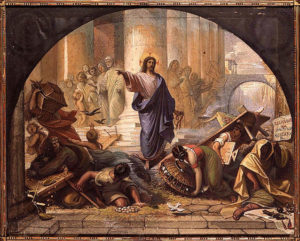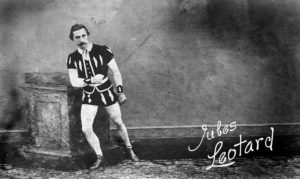[Greek] τράπεζα (trapeza), [Latin] mensa: table, dining table, bank, food, stool, meal, money counter, eating table, food on the table, mat, meat, privileges granted, what is provided on the table; Lk.16:21, Jn.2:15, Act.16:34, Lk.19:23, 1Cor.10:21, Act.6:2, Lk.22:21, Mk.14:18

In the Temple Jesus overturns the tables of the money-changers, bankers, and sellers.
Background Information:
The Dining Table
Early Historical Development: The early notion of the table began with a cloth (leather) mat or wooden plate, which was used to place foods on. The Bedouins in the Near East continue this practice. The form of the table was determined by bodily posture for eating. The Greco-Roman culture developed the custom of reclining on a couch next to a low table. This is depicted in Greek banquet and Roman feasts, where tables are placed in a horse-shoe layout. Servants would serve from the inside area. In palaces and well-to do circles, stools and benches at regular tables would be present.
Palestine: The Palestinian culture borrowed from the Greco-Roman custom. In typical Passover meal settings, it was assumed that the usual posture at ordinary meals was sitting or crouching. Reclining at table was a continuing Hebrew theme of hospitality. This practice typically consisted of supporting oneself on the left arm and using the utensils with the right hand. In Jesus’ world, the common practice was sitting or crouching, except at feasts and banquets. A specific seating arrangement illustrated the seating positions of the master of the house and his guest of honor.
The Moneychangers’ Table
Greco-Roman culture: This was a public location (venue) where various transactions were made. Often near a temple, these places provided for the exchange of money for offerings (sacrifices) to the gods. In addition, other money exchanges and commerce transactions took place. This developed the early sense of a bank. Salesmen, putting their coins on table, became known as money-changers or bankers.
The Table of the Show-Bread
Cultic space: These tables in the Temple were used for cultic purposes. In the Greco-Roman culture, these were offering tables near the idols in the pagan temples. On these tables were placed gifts offered to the deity. In the Old Testament, this was the table for the show-bread. In Hebrew this show-bread literally means “the bread of the face.” The show-bread signified the presence of God. In contrast, the bread of the Last Supper signifies the presence of Jesus.
Scripture:
“And as they reclined at table and were eating, Jesus said, ‘Amen, I say to you, one of you will betray me, on who is eating with me.’” Mk.14:18
This passage refers to table fellowship. Jesus is with His disciples, His inner circle of friends. This betrayal comes from within this inner circle.
“So the Twelve called together the community of the disciple and said, ‘It is not right for us to neglect the Word of God to serve at table.’’ Act.6:2
The Christian community was growing. The Apostles created an additional ministerial position of deacon to handle the finances and serve the poor. This allowed the Apostles to focus on preaching.
“You cannot drink the cup of the Lord and also the cup of demons. You cannot partake of the table of the Lord and of the table of demons.” 1Cor.10:21
This passage speaks to this communion, a sacrificial meal which binds to the Lord of the altar. This communion is incompatible to other meals or offerings to other gods. One cannot alternate between the two meals.
“Why did you not put my money in a bank? Then on my return, I would have collected it with interest.” Lk.19:23
This is a place where money is kept or managed or where credit was established. These venues were run by bankers or moneychangers.
Early Christianity: Early Christian worship was a feast embracing Word and sacrament. Primitive worship took place in private homes and gathering around tables. Once the sacramental meal was distinguished from the general meal, a table was specifically used for the consecration. This consecration table was later called an altar. From the later 3rd century on, this Eucharistic table was honored as the holy place.

Trapeze: The art of trapeze performance was developed by Jules Leotard, a French acrobat and aerialist. He invented the flying trapeze. This stretchy, tight fitting garment was made famous by him. It was in the 1920’s and 1930’s that this fabric influenced the style of bathing suits.
Conclusion:
Trapeze, trapezoid, trapezius (muscle), mesa
A trapezoid, meaning “table-like”, has two parallel sides. A trapeza comes from “tetras” (four) + “peza” (foot). The trapezius muscle is kite-shaped muscle which stabilizes the shoulder blade and extends the head at the neck. The trapeze, connected to the ceiling (top), forms a trapezoid shape. The trapeze bar is always parallel to the ceiling.
